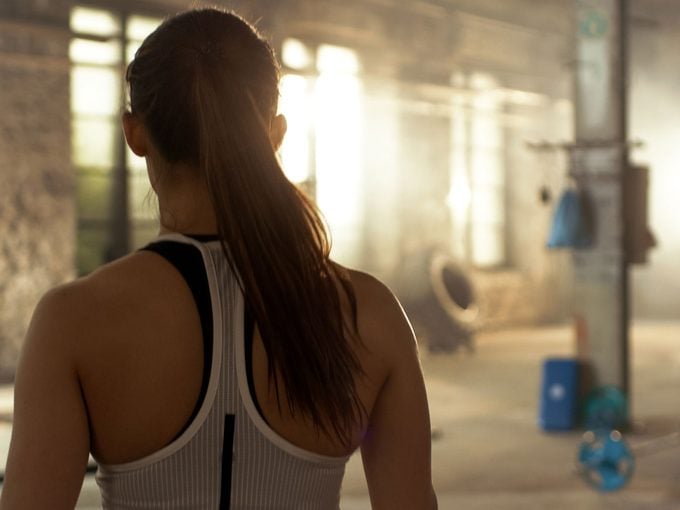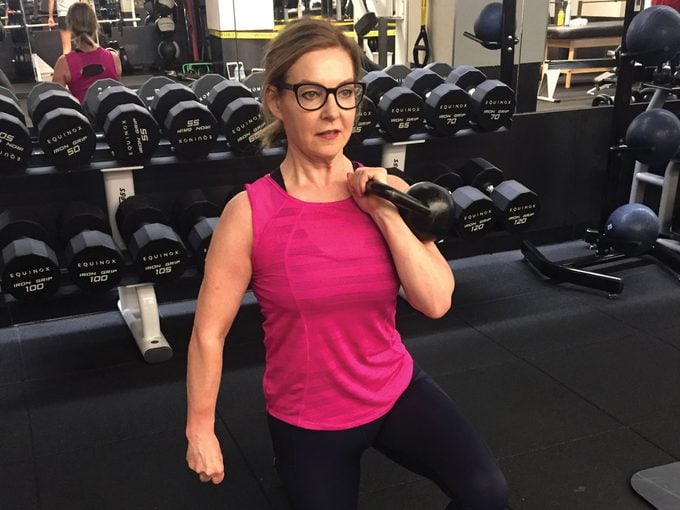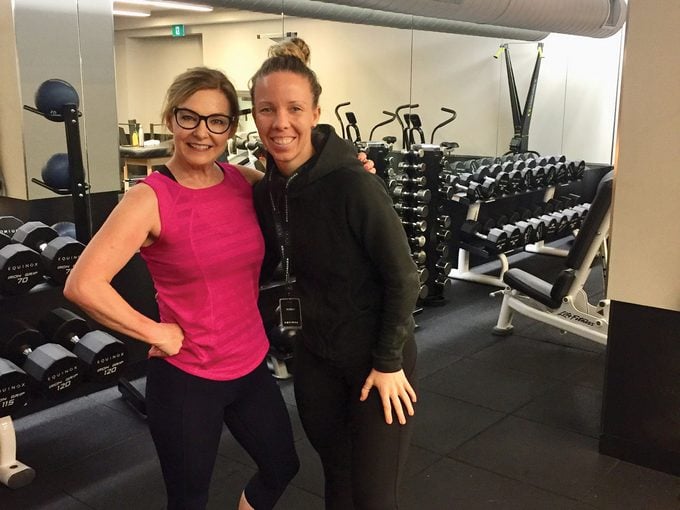How Exercise Helped Our Editor Cope With Her Grief
When editor Beth Thompson's life derailed, an encounter with a personal trainer became an unlikely ticket back to something resembling a life.

Confession: I’ve never had a gym membership.
Icky memories of high-school PE class combined with a fear of not being club-worthy kept me from signing up for one. Instead, I homeschooled my fitness with magazine workouts and weekend hikes. It worked forever, until forever ended.
On a sunny Saturday last fall, when I should have been making anniversary plans with my husband, I was, instead, making funeral arrangements for my husband. It was the shocking last act of a 32-day stay in the ICU where my beloved Rick succumbed to a raging and relentless infection. My three sons and I stumbled out of the hospital that October afternoon, a knotted broiling mass of grief. Rick’s pain was over, mercifully — but ours was just beginning.
Death happens in an instant; moving on, not so much. I have spent 2018 just trying to stay upright. Grief is fatiguing. It can also wreak havoc on your health. For me, it presented as ridiculously high blood pressure. I knew exercise and eating well were key to my recovery, but I couldn’t work up the energy to care. Enter the universe.
I got a call at work one day, asking if I’d like to participate in a summer series of high-intensity interval training (HIIT) classes at Equinox, a high-end fitness club with Toronto and Vancouver locations. My unstable high blood pressure made me ineligible to participate. When I explained my hypertension, I got this response: “We can help with that. How would you like to train with a professional?” I was intrigued by the offer but hesitant. (This is how a personal trainer-client relationship actually works.) My life had shrunk to such a small footprint that the idea of being scrutinized in a bustling gym environment for six weeks terrified me.
But somewhere between a flat-out no and a list of excuses, my heart recognized what my head could not yet accept: I needed to get healthy. My blood pressure was spiking, and I was facing more potent meds to manage this silent killer.
And even though I was no longer a wife, I was still, most assuredly, a mother. A mother who could not bear the sight of her sons’ shoulders slumped with sorrow, incapable of taking on one more ounce of loss. I called Equinox back. “When do I start?”
The assessment
On my first day, I meet Robyn Smith and knew immediately that I’m in good hands. One of Equinox Yorkville’s master instructors, Smith studied kinesiology and exercise physiology and now specializes in assessing individual biomechanics and developing specialized training programs to improve movement competency, building resilience through strength. Still, I’m nervous and my blood pressure gives that away. It’s a startling 183/120. But as we begin chatting about my goals and our plans to achieve them, I start to settle into the moment.
Bottom line, says Smith, is that to lower my blood pressure, my body needs to work more efficiently. My two days a week with her will focus on making that happen, relearning how to move properly and safely with basic strength training exercises like lunges, lifts and squats. She knows what movements incite blood pressure (sudden postural changes, Valsalva [breath-holding], prolonged bracing, heavy loads) and creates a routine that minimizes these risks. My homework is to build up my cardio efforts.
This one-two punch, combined with a double down on clean eating, should help with another goal: To redefine my body composition. Ideally, I should drop 10 pounds of fat and add two pounds of muscle. This is less about looking good in a bikini (um, that’s never happening) and more about improving heart health; lean mass has a greater capacity to move and use oxygen so that the heart doesn’t have to do all the heavy lifting.
The beginning
My first training days are just a blur of embarrassments. The most basic instructions need to be repeated at least twice, and each ensuing movement leaves me wobbly and a bit dizzy. These last issues are fouls on my part — I’m not engaging my core, and I’m forgetting to breathe. Ever patient, Smith helps me correct. “Inhale now, exhale here,” she says softly, repeating the move with exaggerated breathing. Her tip for keeping my core strong is genius. “Think of it as a cereal box with a giant X: Right shoulder to left hip; left shoulder to right hip. Keep it strong and don’t let it crumple in half.” The imagery works until I become fatigued to the point of forgetfulness and find myself bent in two, panting like a dog on a hot day.
This is exactly the moment where my fear of personal trainers heightens. Blame it on TV, but I have this idea that the weaker the trainee, the angrier the trainer. Visions of drill sergeants barking expletives dance in my head. Smith is not that. She is the first to admit that she will push clients as necessary, but she is more invested in the victory of momentum. “I push my clients to a certain degree. But at the end of the day, forward is forward. You take one step, you take a leap; it doesn’t matter as long as you’re going toward your goal.” This is a mantra I can wrap my head around. (Here are 5 inspiring mantras to help you hustle harder.)

The halfway point
We’re three weeks into training and I’m not feeling like I’ve made many gains. Every sequence is still a struggle that leaves me gasping for air. When I share this observation with Smith, a sly smile crosses her lips: “The thing about training is that it never gets easier. As soon as you master one thing, we make it harder.” At first blush, that feels defeating, but then I realize the truth: I’m making progress! I’m adding heavier weights, moving with a degree of control and fluidity and recovering more quickly between sets. It inspires me to challenge my cardio sessions. In a moment of puffed-up confidence, I decide to shun the safety net of the treadmill for a real-world trail excursion.
What the hell was I thinking? Two kilometres in, I recognize that this is the worst decision of my life. “I will have a heart attack on the trail and leave my sons orphaned” is my predominant belief as my fingertips and ear-lobes pulse hot with blood. Once the nausea hits me though, my only thoughts are about barfing and crying. I don’t barf. I do cry. This is hard. I miss Rick. I want forever back.
That’s a wrap
I’m lousy with endings. I realize this fact as I walk into my last session with Smith, beset with sadness when I should be happy. Over the past six weeks, I’ve put in the work and made good gains. My blood pressure is down to 122/88, I’ve dropped 10 pounds and toned up some wobbly bits. I’ve even triumphed over my disastrous virgin run. Now I hit the trail with Smith’s voice in my ear, helping me correct each deficit: “Stay tall and don’t crumple your cereal box. Manage at your own pace. Breathe!”
Lesson learned — in fact, so many lessons learned. This ultimately, is what makes me so emotional about saying goodbye. My successes over these weeks are all due to Smith, who understood what I needed to get healthy and then encouraged, cajoled and, yes, pushed me to get there. True story: I would not have done this on my own.
There are a million bits of brilliance I want to extract from Smith in the dying moments of our session, but the last personal question I ask is: “What’s the one thing I need to keep on repeat in my head?” She doesn’t hesitate: “Oh my God, trust yourself. That’s the big thing for most people — for you, especially. Trust yourself that you can do it. It hasn’t even been two months and you’ve made significant changes.”
It’s a come-to-Jesus moment for me. I have been so afraid of this whole experience — the gym, the trainer, the expectations — that I have had zero faith in myself, to the point of sabotaging greater success. As that epiphany flits across my face, she seizes on it. “You just have to do one thing and then that gives you the confidence to do the next thing. As long as you have that forward trajectory, then you have your eye on the prize. You’re still doing a lot better than people who think they can’t.”

And, cut.
Life rarely rewards us with Hollywood endings, but it does throw enough bits of tinsel our way to help us see the light. My boys and I are still a broiling mass of grief, but we are beginning to unknot, beginning to stretch our limbs, our lives. My time at the gym has helped me appreciate this life truth: Moving on includes as many sideways stumbles as it does forward lunges— and that’s OK. Sometimes we need to falter to figure out the best way to advance. As Smith would say: “You’re moving forward. No matter how slowly, you’re still moving.”




